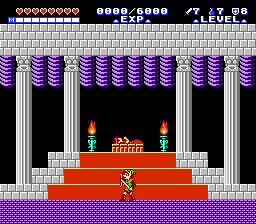Released: Jan 14, 1987
Version played: Zelda II Redux (2021)
To call Zelda II ahead of its time is like calling John Wick kinda good at reloading. You don’t understand. He is so fucking good at reloading.
This project has taken a slight pause due to home life circumstances and as I looked at my schedule I realised there was a gaping hole in its lineup, there are many games I will be skipping simply due to the limits of a human lifespan, but this one had skipped entirely through the cracks. After all, it’s Zelda. Is it really an RPG?
Zelda II, of course, actually is. Along with next weeks game, no prizes for guessing what it is, Zelda II is a trailblazer in the now so common as to be invisible art of bolting RPG mechanics onto something previously number free. In 2025, an action game is not complete without at least three currencies and two skill trees, and really we don’t start considering it an RPG til there’s also a loot system there. But in 1987, making it so Link could level up was a monumental change to the fundamental mechanics of the interactions of the game.
It is harder to find a more concise and immediate explanation of what an RPG is than to play Zelda II for five minutes. The Legend of Zelda is a game in which fighting enemies is almost always the loser’s choice. There are item drops but the cost/benefit for engaging with enemies means that you will generally lose more resources than you gain in a fight. This is the core of Zelda’s challenge, and dungeons regularly lock you in rooms with specific combat encounters that you need to master to have the resources to traverse the dungeon. In an RPG like Zelda II this dynamic is entirely inverted, as your strength is gained directly from engaging in combat in the first place. An adventure game about using all your tools to avoid traps and explore dungeons becomes, primarily, a game about hitting guys with a sword.
What’s interesting about Zelda II is just how much Nintendo recognised this fundamental changed and leaned in. The new camera angle emphasises reading enemy attacks and tells, the player will be constantly looking for openings between animations to fit in attacks of their own, all while managing when and where to position their block. I’m not going to say it. You already know.
Famously, however, this forward thinking ambition led to a released game with creaky foundations, especially in America. The NPCs talk total nonsense in the released version, the enemies are brutal in every version, and the game is just generally really hard and annoying. Interestingly this brings the game closer to its RPG brethren when it comes to dungeon crawling, but you don’t become Nintendo by appealing to the Wizardry fans. This leads to a game divisive for its execution not its ideas, and yet its ideas pay the price anyway as Zelda III would be Link to the Past and truly cement the Miyamoto formula of just making the last game again and refusing to depart from a formula that has hardened to stone. They got away with it by somehow still making the best games ever. Bastards.
Which leads to Zelda II’s position today being far more dynamic than it was decades ago. I played the Redux hack, a fantastic rebalancing and (most importantly) retranslation to enable to you to play without a guide and enjoy the exploration. In this context the game sings and would fit right in with all the other throwback Soulslikes on Steam today. With no help of Nintendo themselves, it has never been easier to enjoy Zelda II and see the well trodden path it helped carve, without turning into the Angry Video Game Nerd.

